The half-inch of rain last weekend brought out a few more flowers, and today the theme was purple and yellow. The most intense yellow belonged to the claspleaf coneflowers, damp-ground lovers, here in the swale below the #3 gabion. The lacy white in the foreground bears the unlovely name of beggars’ ticks, for its adherent seeds.
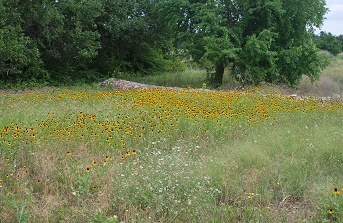
Hidden among the coneflowers were a few lemon horsemint, their purple striking against that strong yellow.
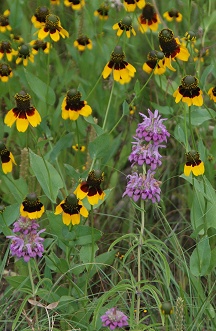
Up out of the damp-ground areas and into the dry woods, where there is basically no soil, just rocks, the skeleton flowers were in bloom. These lovely delicate flowers grow on naked stalks that appear to rise from the most unlikely ground.
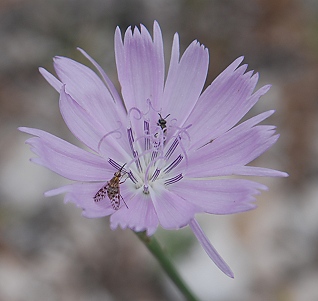
I’m very fond of them and was happily taking pictures of each one (we have more than we used to) when I realized that I’d never seen that fly before. I’m not sure about the insect across the flower from it (they seemed wary of one another) but that one was shyer. Pretty spotted wings…so I had to close in for a tight shot that I hope will be identifiable to some entomologist. [EDITED 11:56 pm] And with thanks to Jack L. Neff, it’s been identified as a fly probably in the genus Poecilognathus.
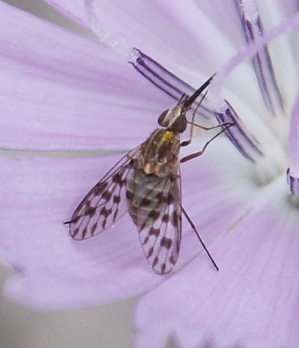
After that, it was time to check on our dry woods yuccas–almost through blooming (and with very short stalks, as it has been a dry year.)
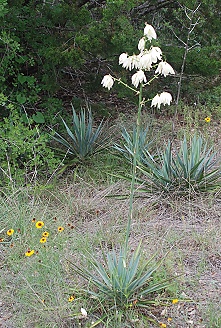
The yuccas in the background didn’t bloom this year, but the yuccas in this area have been increasing in the years since we got the place.
Comment by Doranna — May 23, 2009 @ 4:05 pm
I love the way nature puts purple and yellow flowers together–complimentary colors. I mean…how does it know?? But it always does…
Comment by Chuck — May 23, 2009 @ 5:08 pm
My Mississippi-born parents always called the white flowers “beggar-lice” — but I always wondered if there might not be some connection with Queen Anne’s Lace? Vernacular names and folk-etymology, you know.
Comment by elizabeth — May 24, 2009 @ 3:09 pm
The “beggar’s ticks” or “baggar’s lice” name is an example of why popular names of plants aren’t reliable…there’s a plant in Europe called the same thing that isn’t anything like ours. The key here is small adherent seeds. I’m not sure what it is…but I’ll keep trying to pin it down.
Comment by Barb — May 24, 2009 @ 4:23 pm
Is it perhaps also hedge parsley (torilis arvensis)? If so, it is related to carrots and Queen Anne’s Lace. (Ain’t Google wonderful? Talk about your time sink!)
Comment by elizabeth — May 24, 2009 @ 4:49 pm
Sure could be. Some of the images online look like it, and the habitat spread is right. There’s a field south of town completely white with it this year–this is a field that was…um…mishandled a few years back and since then has grown only invasive forbs, like this one.
Thanks for finding it. I knew it had to be in the carrot family, but hadn’t found it in my other guidebooks.
Comment by cdozo — June 1, 2009 @ 10:09 am
There are wonderful pictures and that spotted fly is fantastic.
Comment by elizabeth — June 1, 2009 @ 10:15 am
I grew up thinking of all flies as black or gray, ugly, filthy, swat ’em. I had no idea there was such beauty among the Diptera.
Because I didn’t look…